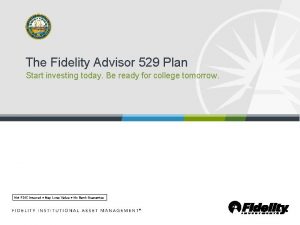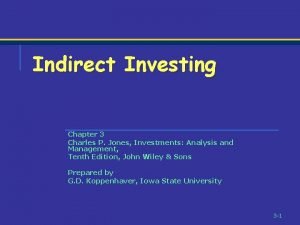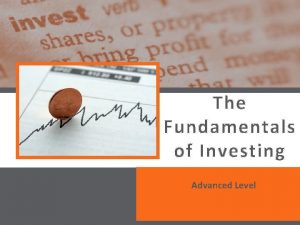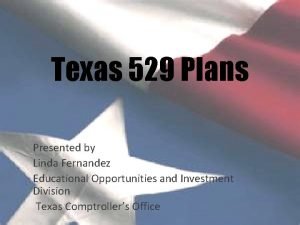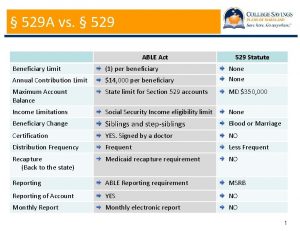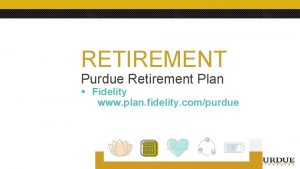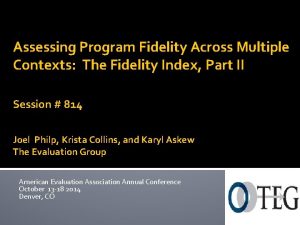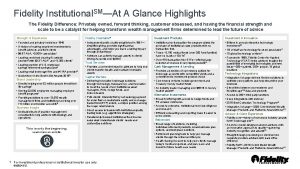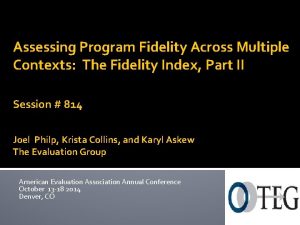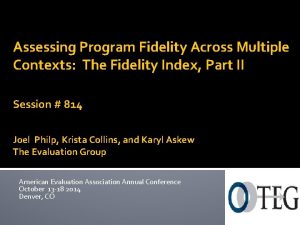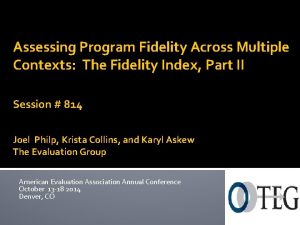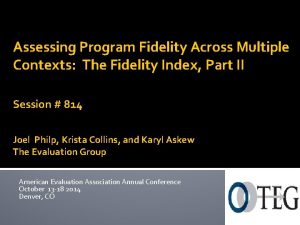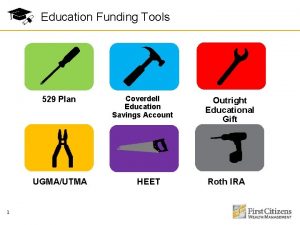The Fidelity Advisor 529 Plan Start investing today


















- Slides: 18

The Fidelity Advisor 529 Plan Start investing today. Be ready for college tomorrow. Not FDIC Insured May Lose Value No Bank Guarantee ®

Learning Objectives Upon completion of this seminar, you will be able to: 1 Communicate to clients the importance of college savings in light of escalating costs 2 Explain how a 529 works and its potential tax advantages 3 Review the features of different college savings options This seminar is defined as basic level for your continuing education credit. 2

Many Underestimate Future Costs of College Parents of high school kids underestimated the cost of college by an average of $70, 000 What Parents of Kids in High School Estimate Four Years of College Will Cost Average Projected Sticker Price for Four Years of College 1 $218, 000 + College costs are increasing an average of $145, 000 3% per year $143, 000 + $77, 000 Public Institution Private Institution Source: Fidelity Investments 2016 College Savings Indicator Study, August 2016. 1 College Board, "Trends in College Pricing 2016, ” October 2016. Estimates assume the cost of college is growing at 2. 98% each year. A straight average of total charges (tuition, fees, room and board) for a combination of public and private four-year colleges was used for this calculation. Note that total expenses include books, supplies, transportation, and other costs. 3

The College Savings Gap Continues Parents intend to cover less and are still not on track to reach their goal Percentage Parents Intend to Cover Has Decreased 70% Percentage of Their College Funding Goal They Are on Track to Save 62% 24% 2016 2018 2016 28% 2018 About the Fidelity Investments 2018 College Savings Indicator Study: As part of the study, Fidelity conducted a survey of parents with college-bound children of all ages. Parents provided data on their current and projected household asset levels, including college savings, use of an investment advisor, and general expectations and attitudes toward financing their children's college education. Using Fidelity's proprietary asset-liability modeling engine, the company was able to calculate future college savings levels per household against anticipated college costs. The results provided insight into the financial challenges parents face in saving for college. Data for the Indicator (number of children in household, time to matriculation, school type, current savings, and expected future contributions) was collected by Boston Research Technologies, an independent research firm, through an online survey from May 15 to June 15, 2018, of 1, 899 parents nationwide with children aged 18 and younger who are expected to attend college. The survey respondents had annual household incomes of at least $30, 000, and were the financial decision-makers in their household. College costs were sourced from the College Board's Trends in College Pricing 2017. Future assets per household were computed by Fidelity Personal and Workplace Advisors LLC (FPWA), a registered investment advisor and a Fidelity Investments company. Within Fidelity's asset-liability model, Monte Carlo simulations were used to estimate future assets at a 75% confidence level. The results of the Fidelity College Savings Indicator may not be representative of all parents and students meeting the same criteria as those surveyed for this study. 4

Invest in a Child’s Future The Fidelity Advisor 529 Plan can help make a college education happen College is the third-most important saving goal for parents, ahead of retirement. 1 Plan Advantages When you invest your money for college in a 529 plan account, your earnings grow tax deferred and qualified withdrawals are free from federal income taxes. 2 Pay for K– 12 tuition up to $10, 000 per year tax-free. 3 Control and Flexibility Unlike other savings accounts, a 529 offers the owner complete control of the account, even after the beneficiary turns 18. No income requirements for opening an account. Make tax-free distributions to repay student loans ($10, 000 lifetime limit) and pay for certain apprenticeship program expenses. 4 Accelerated Gifting Accelerated gifts may increase a 529 plan account balance over time, thanks to compounding. 5 Assets gifted to a 529 plan are considered immediately removed from the donor’s estate, which may help reduce or eliminate estate taxes. 1 “How America Saves for College, ” Sallie Mae, 2018. 2 When used for qualified higher education expenses, such as tuition and room and board. 3 Up to $10, 000 per taxable year in 529 account assets per beneficiary may be used for tuition expenses in connection with enrollment at a public, private, or religious elementary or secondary educational institution. Although the assets may come from multiple 529 accounts, the $10, 000 qualified withdrawal limit will be aggregated on a per-beneficiary basis. The IRS has not provided guidance to date on the methodology of allocating the $10, 000 annual maximum among withdrawals from different 529 accounts. Any distributions in excess of $10, 000 per beneficiary may be subject to income taxes and a federal penalty tax. Assets may be used to repay up to$10, 000 in student loans for the beneficiary or a sibling of the beneficiary. 4 The Setting Every Community Up for Retirement Enhancement (SECURE) Act. The definition of qualified higher education expenses for 529 plans expanded to include amounts paid as principal or interest on any qualified education loan of a 529 plan designated beneficiary or a sibling of the designated beneficiary. The amount treated as a qualified expense is subject to a lifetime limit of $10, 000. The definition of 529 plan qualified higher education expenses also expanded to include expenses for fees, books, supplies, and equipment required for the participation of a designated beneficiary in an apprenticeship program registered and certified with the Secretary of Labor under section 1 of the National Apprenticeship Act. These provisions are applicable to distribution made after December 31, 2018. 5 In order for an accelerated transfer to a 529 plan (for a given beneficiary) of $75, 000 (or $150, 000 combined for spouses who gift split) to result in no federal transfer tax and no use of any portion of the applicable federal transfer tax exemption and/or credit amounts, no further annual exclusion gifts and/or generation-skipping transfers to the same beneficiary may be made over the same five-year period, and the transfer must be reported as a series of five equal annual transfers on Form 709, United States Gift (and Generation-Skipping Transfer) Tax Return. If the donor dies within the five-year period, a portion of the transferred amount will be included in the donor’s estate for estate tax purposes. 5

Give a Gift That Gives Back Accelerated gifting can benefit everyone For the Receiver Accelerated gifts may result in a larger 529 plan account balance over time, thanks to compounding. 1 Accelerated gifting limit numbers per beneficiary: For the Giver Assets gifted to a 529 plan are considered immediately removed from the donor’s estate, which may help reduce or eliminate estate taxes. Single Filer $75, 000 Married Filer $150, 000 1 In order for an accelerated transfer to a 529 plan (for a given beneficiary) of $75, 000 (or $150, 000 combined for spouses who gift split) to result in no federal transfer tax and no use of any portion of the applicable federal transfer tax exemption and/or credit amounts, no further annual exclusion gifts and/or generation-skipping transfers to the same beneficiary may be made over the same five-year period, and the transfer must be reported as a series of five equal annual transfers on Form 709, United States Gift (and Generation-Skipping Transfer) Tax Return. If the donor dies within the five-year period, a portion of the transferred amount will be included in the donor’s estate for estate tax purposes. 6

Take Advantage of Accelerated Gifting Grandparents can help fund college with accelerated gifts. 1 Grandparents The grandparents in this example immediately reduced their estate by over $450, 000 by giving each of their three grandchildren five years’ worth of gifts in one year—all while avoiding the gift tax. 1 No further gifts to the same beneficiary may be made over the next five-year period. The gift must be reported as a series of five equal annual gifts on federal gift tax returns. See the offering statement for more information. 7

Make the Most of Every Dollar Tax-deferred investing may translate into more money for college HYPOTHETICAL EXAMPLE $ 200, 000 $ 181, 121 $ 150, 000 Over 18 years, an advantage of more than Tax-deferred (529) account $ 149, 473 $ 100, 000 $ 50, 000 $31, 000 Taxable account $ $0 0 1 2 3 4 5 6 7 8 9 10 11 12 13 14 15 16 17 18 Years HYPOTHETICAL EXAMPLE This hypothetical example compares the after-tax amounts potentially available at the end of the 18 years after investing in a tax-deferred (529 plan) account versus a taxable account. Assumptions include an initial after-tax investment of $10, 000 and a $350 monthly after-tax investment at a 7% annual rate of return compounded monthly for 18 years for the taxdeferred (529 plan) account. The taxable account assumes an imputed constant annual federal-income-tax rate of 25% on earnings. Local and state taxes, inflation, fees, and/or expenses are not taken into account. If they had been deducted, performance would have been lower. The ending value of the tax-deferred (529 plan) account assumes all distributions will be used for qualified higher education expenses and, therefore, are federal income tax free. Investors may realize capital gains or capital losses in any year that they sell fund shares within a taxable account, although this example does not take into account capital loss carried forward or other tax strategies used to reduce taxes that could be incurred in a taxable account. Lower capital gains or dividend tax rates or tax rates in general would make the return for the taxable account more favorable. The earnings on distributions from a 529 plan not used for qualified higher education expenses are subject to federal income taxes and a 10% penalty. See last slide for important information on all hypothetical examples. 8

Capture the Greatest Growth Potential Every year you wait may be a missed opportunity HYPOTHETICAL EXAMPLE Age of Child When Investing Begins Invest $350 a month for 18 years in a tax-deferred account, assuming a 7% annual rate of return. Years until College Potential Accumulation by College Age Potential Missed Opportunity* Newborn 18 $148, 154 $0 1 year old 17 $134, 389 $13, 765 3 years old 15 $109, 502 $38, 652 5 years old 13 $87, 765 $60, 389 The chart is not intended to predict or project the performance of any investment. Past performance is no guarantee of future results. * Represents amounts that could have been accumulated in a hypothetical tax-deferred (529 plan) account but that may have been accumulated in other investment vehicles instead. Other investment vehicles may offer tax-free or tax-deferred savings opportunities. Assumptions include regular monthly investments of $350 into a tax-deferred account (529 plan) at a 7% annual rate of return compounded monthly over a series of different time periods (18, 17, 15, and 13 years). The regular monthly contributions are assumed to be made at the beginning of each month. Local and state taxes, inflation, fees, and/or expenses are not taken into account. If they had been deducted, performance would have been lower. The ending value of the tax-deferred (529 plan) account assumes all distributions will be used for qualified higher education expenses and, therefore, are federal income tax free. Any earnings on nonqualified distributions from 529 plan accounts are subject to federal income taxes at the distributee’s rate as well as a 10% federal penalty tax. Periodic investment plans do not guarantee a profit or protect against a loss in a declining market. See last slide for important information on all hypothetical examples. 9

Minimal Impact on Financial Aid A 529 plan affects financial aid less than many people realize Earnings from a 529 used to pay for college expenses are not considered part of parental or child income. Savingforcollege. com, 2018. 10 Today’s federal financial aid formula considers roughly: 5. 6% of parents’ assets (for example, a 529 plan) 20% of child’s assets in a tax‐deferred account (for example, a UGMA/UTMA)

In-State versus Out-of-State 529 Plans Calculating the actual benefit HYPOTHETICAL EXAMPLE* • You invest $10, 000 in an in-state 529 plan. • Your state allows you to deduct $2, 000. 1 Multiply state’s maximum allowed deduction by state tax rate. $2, 000 deduction x 5% tax rate = • The state tax rate is 5%. • You are in the 33% federal tax bracket. 2 State tax rebates are taxed at federal tax levels. Multiply the bracketed figure by (1–federal rate). [$100] x (1– 33%) Visit institutional. fidelity. com/529 for a link to the State Tax Deduction Calculator. * Not based on any specific state’s 529 tax deduction or state income tax rates. See last slide for important information on all hypothetical examples. 11 $67 benefit

Choose the Investment Tradition of Fidelity The Fidelity Advisor 529 Plan offers a fluid, age-based approach to help meet changing allocation needs 100% Short Term Allocation 80% 60% 40% Bonds 20% Non-U. S. Equity 0% 0 1 2 3 4 5 6 7 8 9 10 11 12 Beneficiary’s Age 13 14 15 16 17 18 19 20 21 Allocations shift gradually each year. These offerings use active asset allocation to over- or underweight certain asset classes to take advantage of market conditions and opportunities. The above glide path chart illustrates the approximate asset allocation among U. S. Equity Funds, Non-U. S. Equity Funds, Bond Funds, and Short-Term Debt Funds, relative to a beneficiary's investment time horizon. The chart also illustrates how these allocations may change over time. The actual asset allocations may differ from this illustration. This table is not intended to represent current or future allocations in any portfolio. The illustration represents a revised asset allocation strategy effective October 1, 2019, the full implementation of which is expected to be completed by 3/31/20. 12 22

Fitting a 529 Plan into Your Overall Financial Plan Your advisor can help 8 Age-Based Portfolios 2 Static Allocation Portfolios • Gradual, automatic reallocation of portfolio assets • Fidelity Advisor 529 Aggressive Growth Portfolio • Fidelity Advisor 529 Moderate Growth Portfolio 17 Individual Fund Portfolios Domestic Equity Portfolios Fixed Income Portfolios • Fidelity Advisor 529 Dividend Growth Portfolio • Fidelity Advisor 529 High Income Portfolio • Fidelity Advisor 529 Equity Growth Portfolio • Fidelity Advisor 529 Inflation-Protected Bond Portfolio • Fidelity Advisor 529 Equity Income Portfolio • Fidelity Advisor 529 Limited Term Bond Portfolio • Fidelity Advisor 529 Growth Opportunities Portfolio • Fidelity Advisor 529 Strategic Income Portfolio • Fidelity Advisor 529 New Insights Portfolio • Fidelity Advisor 529 Total Bond Portfolio • Fidelity Advisor 529 Small Cap Portfolio Asset Allocation • Fidelity Advisor 529 Stock Selector Mid Cap Portfolio • Fidelity Advisor 529 Asset Manager 60% Portfolio • Fidelity Advisor 529 Value Strategies Portfolio • Fidelity Advisor 529 Strategic Dividend & Income Portfolio International Equity Portfolio Money Market Portfolio • Fidelity Advisor 529 Diversified International Portfolio • Fidelity Advisor 529 Money Market Portfolio* * You could lose money by investing in this 529 money market investment option. Although the money market fund in which your investment option invests (the “underlying fund”) seeks to preserve its value at $1. 00 per share, the underlying fund cannot guarantee it will do so. An investment in this 529 money market investment option is not insured or guaranteed by the Federal Deposit Insurance Corporation or any other government agency. The underlying fund’s sponsor has no legal obligation to provide financial support to the underlying fund, and you should not expect that the sponsor will provide financial support to the underlying fund at any time. 13

Invest in a Lifetime Your advisor can help you build your plan 1 Open an account 2 Let it grow 3 Get ready for college Median earnings of bachelor’s degree recipients with no advanced degree working full time were 67% higher 1 than those of high school graduates. 1 College Board, Education Pays 2016: The Benefits of Higher Education for Individuals and Society. 14

Fidelity Advisor 529 Workplace Program A great addition to your benefits package Low cost Easy to implement May help improve employee retention Differentiates you to prospective employees Convenient contribution options: • Checking account withdrawal • Payroll direct deposit* * Ask your payroll provider if he or she can process an Automated Clearing House (ACH) file in the required format. 15

Fidelity Makes Participation Easy Simple for you, simple for your employees Complete application to open account Select deduction amounts and investments* Designate beneficiaries Choose contribution method Participant will receive quarterly statements from Fidelity summarizing all account activity * Federal tax law does not allow participants to have direct or indirect control over the investments in a 529 plan account. 16

Your Advisor Makes It Even Easier Your advisor is at your side throughout the process 17 Assists in plan implementation Helps you choose appropriate funding options Provides materials to encourage participation Conducts enrollment meetings Helps employees select investments Communicates plan enhancements

i. fidelity. com/529 Not FDIC Insured May Lose Value No Bank Guarantee The Fidelity Advisor 529 Plan is offered by the state of New Hampshire and managed by Fidelity Investments. If you or the designated beneficiary is not a New Hampshire resident, you may want to consider, before investing, whether your state or the designated beneficiary's home state offers its residents a plan with alternate state tax advantages or other state benefits, such as financial aid, scholarship funds, and protection from creditors. Units of the portfolios are municipal securities and may be subject to market volatility and fluctuation. Effective 10/1/19, Fidelity transitioned the underlying mutual funds in the age-based and static Fidelity Advisor 529 Plan Portfolios to Fidelity Series Funds. Please see the Fidelity Advisor 529 Plan Offering Statement for additional details. Not NCUA or NCUSIF insured. May lose value. No credit union guarantee. Fidelity Investments & Pyramid Design is a registered service mark of FMR LLC. Unless specifically indicated in an investment option’s detailed description, principal invested is not guaranteed at any time, including at or after the target date. Consider your current and anticipated investment horizon and income tax bracket when making an investment decision, as the illustrations presented may not reflect these factors. Systematic investing does not ensure a profit and does not limit loss in a declining market. All hypothetical examples are for illustrative purposes only and do not represent the performance of any security. The assumed rate of return used in these examples is not guaranteed, and you may have a gain or loss when you sell your units. Investments that have potential for a 7% annual rate of return also come with risk of loss. The tax and estate planning information contained herein is general in nature, is provided for informational purposes only, and should not be construed as legal or tax advice. Fidelity does not provide legal or tax advice. Fidelity cannot guarantee that such information is accurate, complete, or timely. Laws of a particular state or laws that may be applicable to a particular situation may have an impact on the applicability, accuracy, or completeness of such information. Federal and state laws and regulations are complex and are subject to change. Changes in such laws and regulations may have a material impact on pre- and/or after-tax investment results. Fidelity makes no warranties with regard to such information or results obtained by its use. Fidelity disclaims any liability arising out of your use of, or any tax position taken in reliance on, such information. Always consult an attorney or tax professional regarding your specific legal or tax situation. Before investing, consider the plan's investment objectives, risks, charges, and expenses. Contact your investment professional or visit institutional. fidelity. com for a free offering statement. Read it carefully before investing. 437024. 23. 0 FIAM-BD FIDELITY DISTRIBUTORS COMPANY LLC, 500 SALEM STREET, SMITHFIELD, RI 02917 1. 792286. 127 0320
 Fidelity advisors 529
Fidelity advisors 529 Indirect investing
Indirect investing Take charge today the fundamentals of investing
Take charge today the fundamentals of investing Get guaranteed education tuition
Get guaranteed education tuition Texas college savings plan
Texas college savings plan Bright directions enrollment form
Bright directions enrollment form Montana college savings
Montana college savings Umr care management
Umr care management For todays meeting
For todays meeting Today's class answers
Today's class answers Proposal kickoff meeting agenda
Proposal kickoff meeting agenda Today lesson or today's lesson
Today lesson or today's lesson Today's lesson or today lesson
Today's lesson or today lesson Today's lesson or today lesson
Today's lesson or today lesson Hi guys how are you today
Hi guys how are you today Before we start our lesson
Before we start our lesson Start spreading the news
Start spreading the news Forevers gotta start tonight
Forevers gotta start tonight Start triage algorithm
Start triage algorithm
